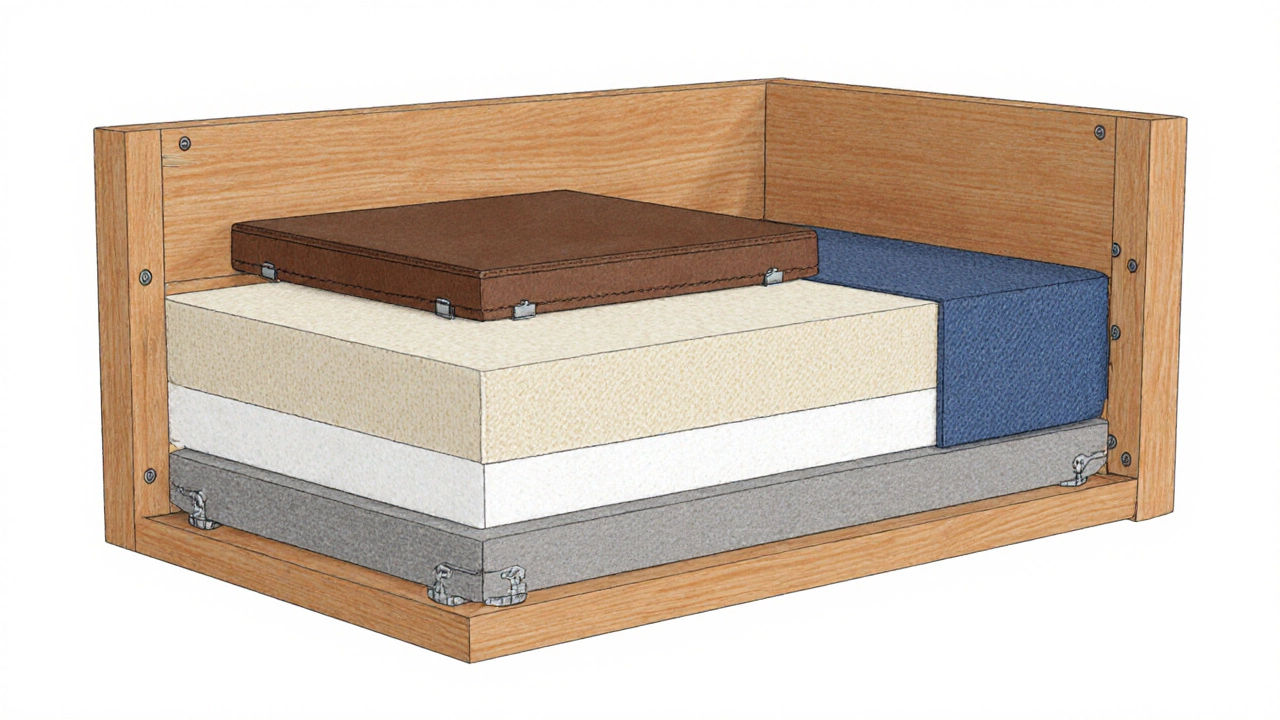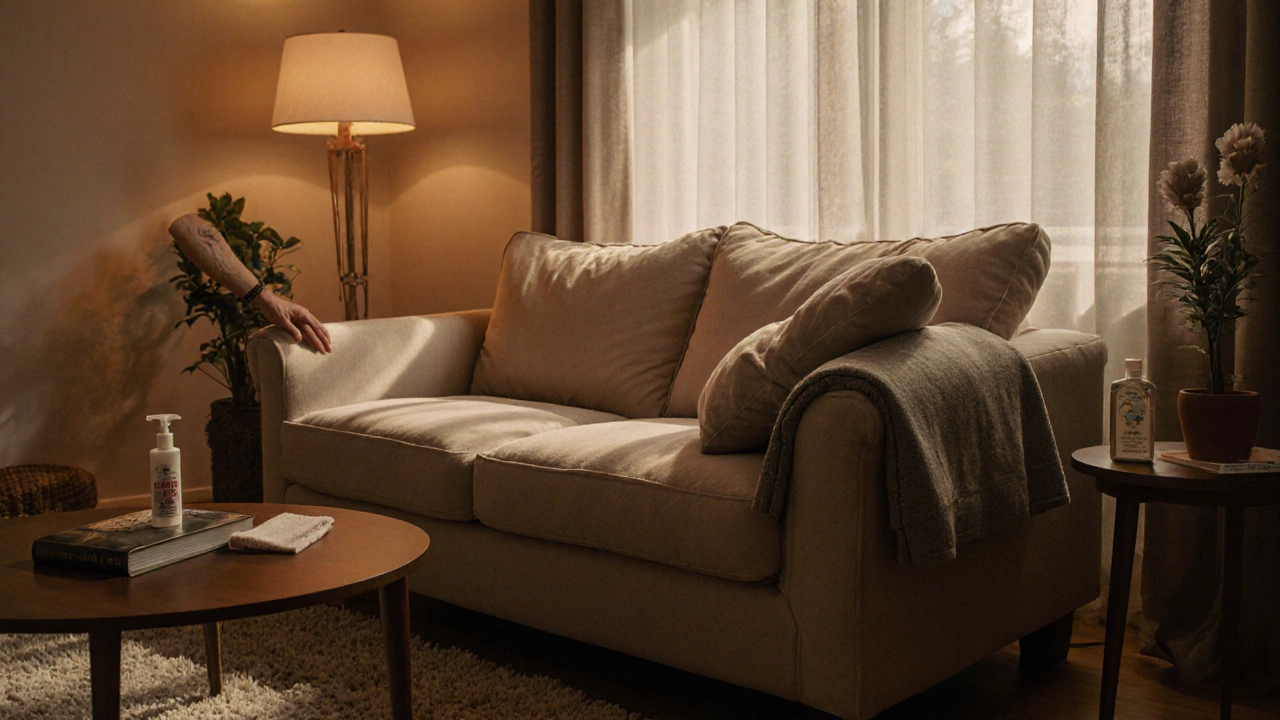 19
Oct,2025
19
Oct,2025
Couch Lifespan Calculator
How Long Will Your Couch Last?
Estimate your couch's potential lifespan based on material choices and maintenance habits
Estimated Lifespan
Your couch could last 0-0 years with these choices.
When you shop for a new Couch an upholstered seating piece that anchors a living room, the first thing on most people’s mind is how long it will stay comfortable and look decent. The answer isn’t a one‑size‑fits‑all number; it hinges on material, construction, how you use it, and a bit of TLC.
Key Takeaways
- Average lifespan ranges from 5 years for low‑budget fabric sofas to 15 years or more for high‑quality leather or solid‑wood frames.
- Frame material (solid wood or metal) is the biggest predictor of longevity.
- Proper maintenance-rotating cushions, cleaning spills promptly, keeping out of direct sunlight-can add 3‑5 years.
- Replace cushions when they lose support; repairing a frame is usually cheaper than buying a new couch.
- Investing a bit more upfront often yields a lower cost‑per‑year over the life of the piece.
What Determines a Couch’s Lifespan?
Think of a couch as a three‑part system: the frame, the cushion fill, and the upholstery. Each part ages differently.
1. Frame - the backbone
The frame bears the weight of everyone who sits down. Solid hardwood (like oak, maple, or beech) can last 20 years or more if the joints are glued and screwed. Wood Frame a sturdy skeleton made from solid timber or engineered wood is far more durable than particleboard or cheap plywood, which may start creaking after just a few years.
Metal frames (usually steel or aluminum) are rust‑resistant and can outlive wood, but they’re prone to bending if the design isn’t robust.
2. Cushion Fill - comfort that fades
Foam cushions lose their bounce as the cells break down. High‑density foam (30 lb/ft³ and above) holds shape for 7‑10 years, while low‑density foam starts feeling flat within 3‑5 years.
Down or feather inserts feel plush but flatten faster, typically 5‑7 years, unless you fluff them regularly.
Foam Cushion a support core made from polyurethane or latex that provides resilience and Down Fill softbird feathers used for a luxurious feel are the most common choices.
3. Upholstery - the skin that shows wear
Fabric sofas are the most affordable but also the most vulnerable to stains, fading, and pilling. Synthetic blends (like polyester‑cotton) can survive 5‑8 years with regular cleaning.
Leather (top‑grain or full‑grain) ages gracefully and can last 10‑15 years if conditioned. Leather a natural hide treated for durability and comfort develops a patina that many owners love.
Microfiber, a tightly woven polyester, offers a middle ground: resistance to stains and a lifespan of about 7‑10 years.
Fabric woven textile used in most budget sofas, Microfiber a synthetic fabric known for its tight weave and durability are the main fabric families you’ll encounter.
Average Lifespan by Material
| Upholstery | Average Lifespan | Pros | Cons |
|---|---|---|---|
| Fabric (cotton/polyester blend) | 5-8 years | Affordable, wide design range | Stains easily, fades in sunlight |
| Microfiber | 7-10 years | Resists spills, soft to the touch | Can pill, less breathable |
| Leather (top‑grain) | 10-15 years | Durable, ages well, easy to wipe | Higher upfront cost, needs conditioning |
| Sectional (mixed fabrics) | 8-12 years | Modular, flexible layout | Complex joints can wear faster |

How to Extend Your Couch’s Life
Even a budget couch can outlive its expected years if you treat it right. Here are practical habits that add years without a big extra spend.
Rotate and Flip Cushions
Every three to six months, rotate seat cushions and flip them upside down. This evens out wear and prevents one side from becoming permanently indented.
Mind the Sun
UV rays break down fibers and fade colors. Use curtains, blinds, or a slipcover if your sofa sits directly under a window.
Spot‑Clean Promptly
Blot spills with a clean cloth-don’t rub. For fabric, a mild upholstery cleaner works; for leather, a leather‑specific cleaner followed by a conditioner keeps the hide supple.
Support the Frame
Avoid jumping or standing on the arms. Heavy weight should be centered on the seat to reduce stress on the frame joints.
Use a Quality Slipcover
In homes with kids or pets, a removable slipcover protects the upholstery from stains and pet hair. Wash it regularly for best results.
When to Repair vs. Replace
Not every sag means the couch is dead. Use these guidelines to decide.
- Frame Issues: If you hear squeaks, see visible cracks, or the joints feel loose, a professional repair (reinforcing joints, replacing broken slats) is usually cheaper than a new couch.
- Cushion Flattening: Replace or re‑upholster cushions when they no longer spring back. Foam inserts are inexpensive and can be swapped without re‑upholstering.
- Upholstery Wear: Deep stains, tears, or extensive pilling may require a new cover. Some upholsterers can refinish leather or re‑upholster fabric for a fraction of a brand‑new price.
- Overall Cost‑Per‑Year: If repairs exceed 30-40 % of the couch’s original price, it’s time to invest in a new, more durable piece.

Cost vs. Lifespan: Making a Smart Purchase
If you buy a couch for $800 that lasts 6 years, you’re paying about $133 per year. A $2,200 leather sofa lasting 12 years drops the yearly cost to roughly $183, but you get superior comfort and style. The key is to balance budget, usage, and expected lifespan.
Look for these value‑adding features when you shop:
- Solid wood frame (kiln‑dried hardwood preferred).
- High‑density foam or a combination of foam + a layer of down for comfort.
- Removable, washable cushion covers for easy maintenance.
- Warranty that covers the frame for at least 5 years.
Quick Checklist Before You Buy
- Check the frame material - solid wood > engineered wood > particleboard.
- Inspect cushion fill - high‑density foam or a foam‑down blend.
- Choose upholstery that matches your lifestyle - leather for low‑maintenance, microfiber for families, fabric for budget.
- Ask about warranty length for the frame and cushions.
- Measure doorways and hallways - a sofa that won’t fit through the front door can cost you a lot in extra labor.
Frequently Asked Questions
How often should I rotate my couch cushions?
Rotate and flip cushions every three to six months. This spreads wear evenly and keeps the seating comfortable longer.
Can a leather couch last longer than a fabric one?
Yes. Full‑grain or top‑grain leather typically lasts 10-15 years with regular conditioning, whereas fabric sofas usually top out at 5-8 years.
What are the signs that a couch frame is failing?
Squeaking, visible cracks, loose joints, or a sagging base are clear indicators that the frame needs repair or replacement.
Is a higher price always a guarantee of longer life?
Not necessarily, but higher‑priced sofas usually feature better frames, denser foam, and higher‑quality upholstery, all of which contribute to a longer lifespan. Always check the specifications.
How can I protect my couch from pet damage?
Use a durable slipcover, trim pet nails regularly, and train pets to stay off the arms. A pet‑friendly fabric like microfiber also resists claws better than delicate linen.
What’s the best way to clean a spilled wine stain on a fabric couch?
Blot the stain with a clean cloth, then apply a mixture of mild dish soap and warm water. Gently dab-not rub-until the stain lifts, then rinse with a damp cloth and let dry.
Understanding the factors that affect a couch’s lifespan helps you make a smarter purchase and keep your favorite seating piece looking and feeling great for years. Remember, the couch lifespan isn’t set in stone-it’s a combination of material quality, how you treat it, and a little bit of routine care.




